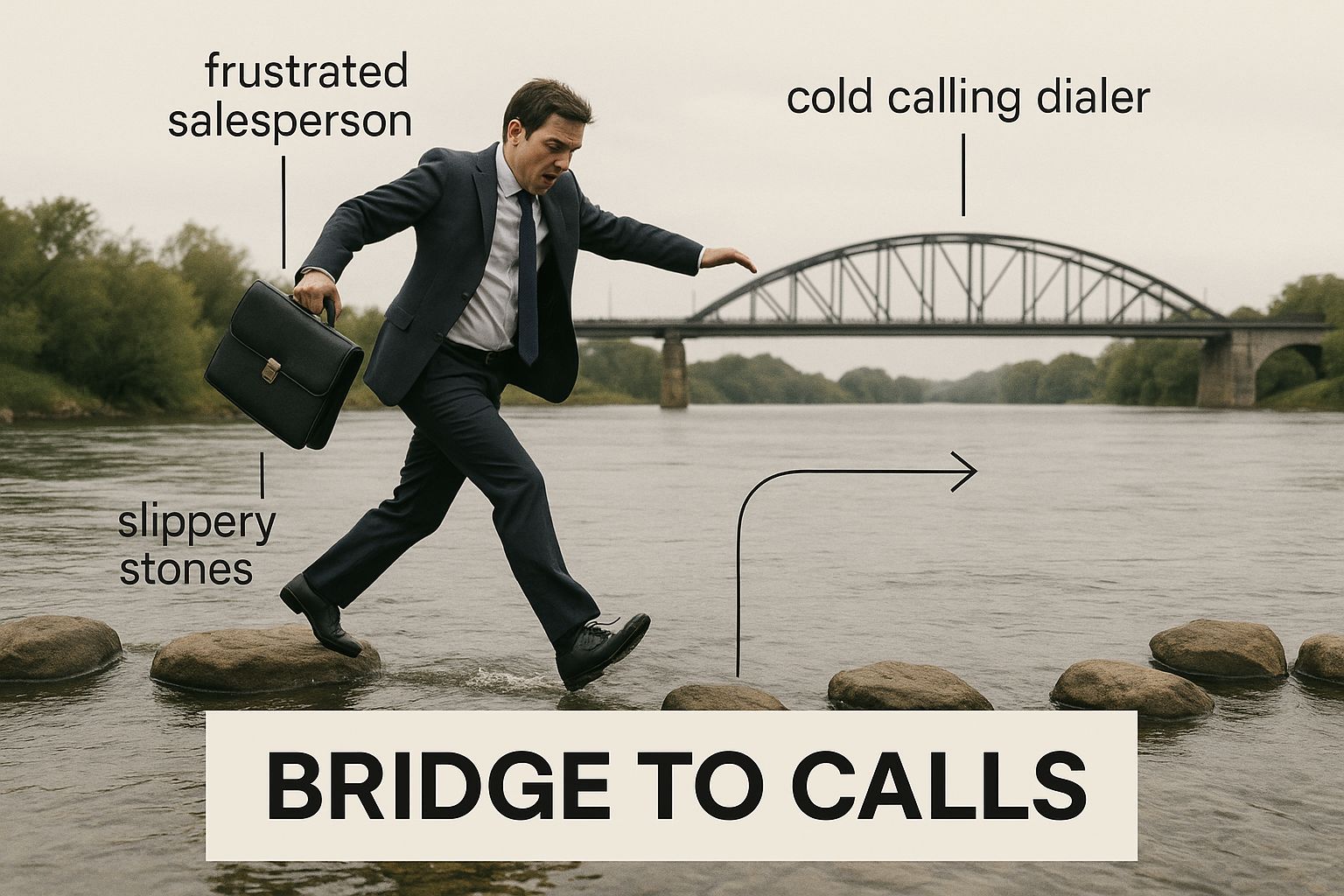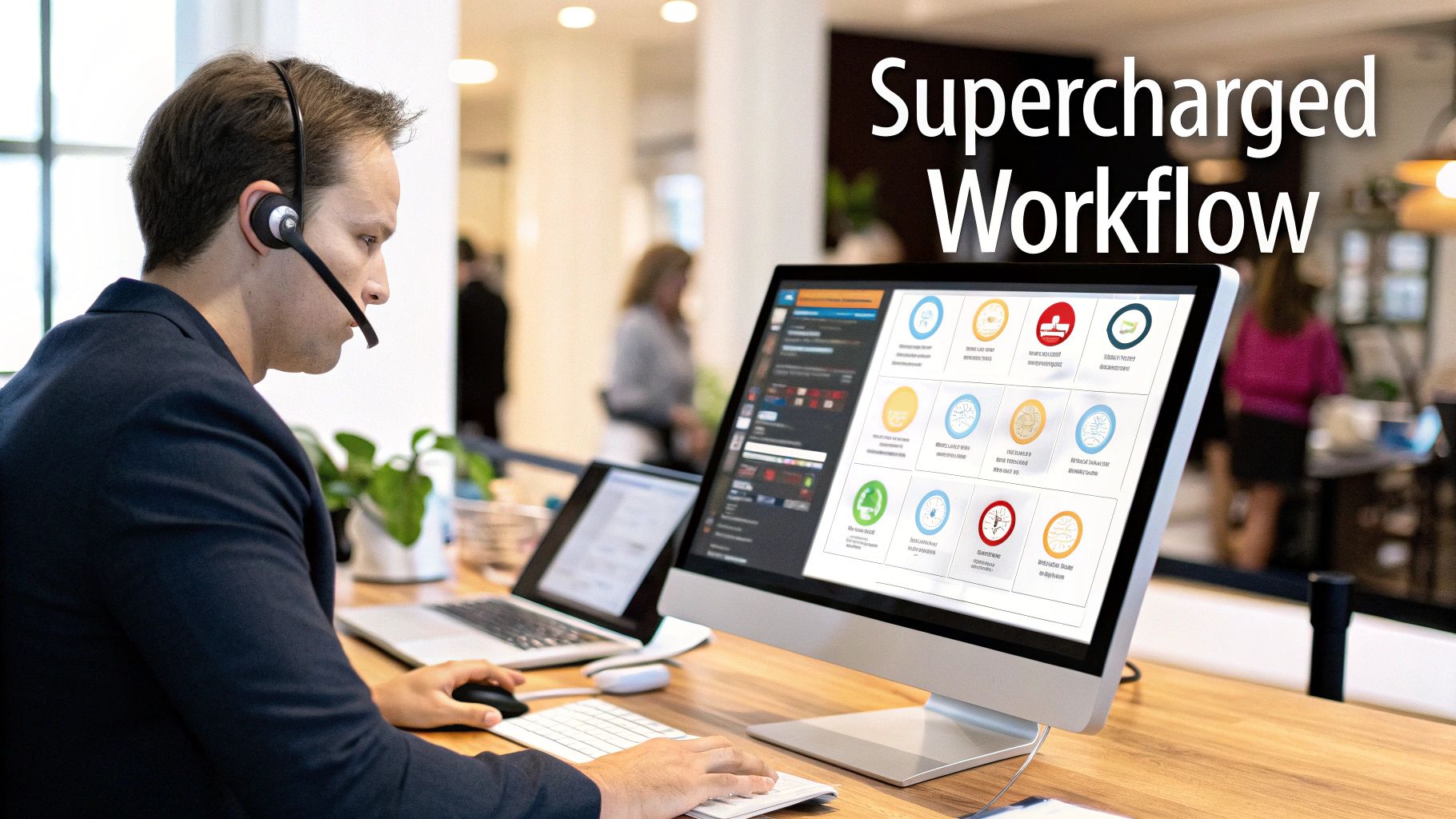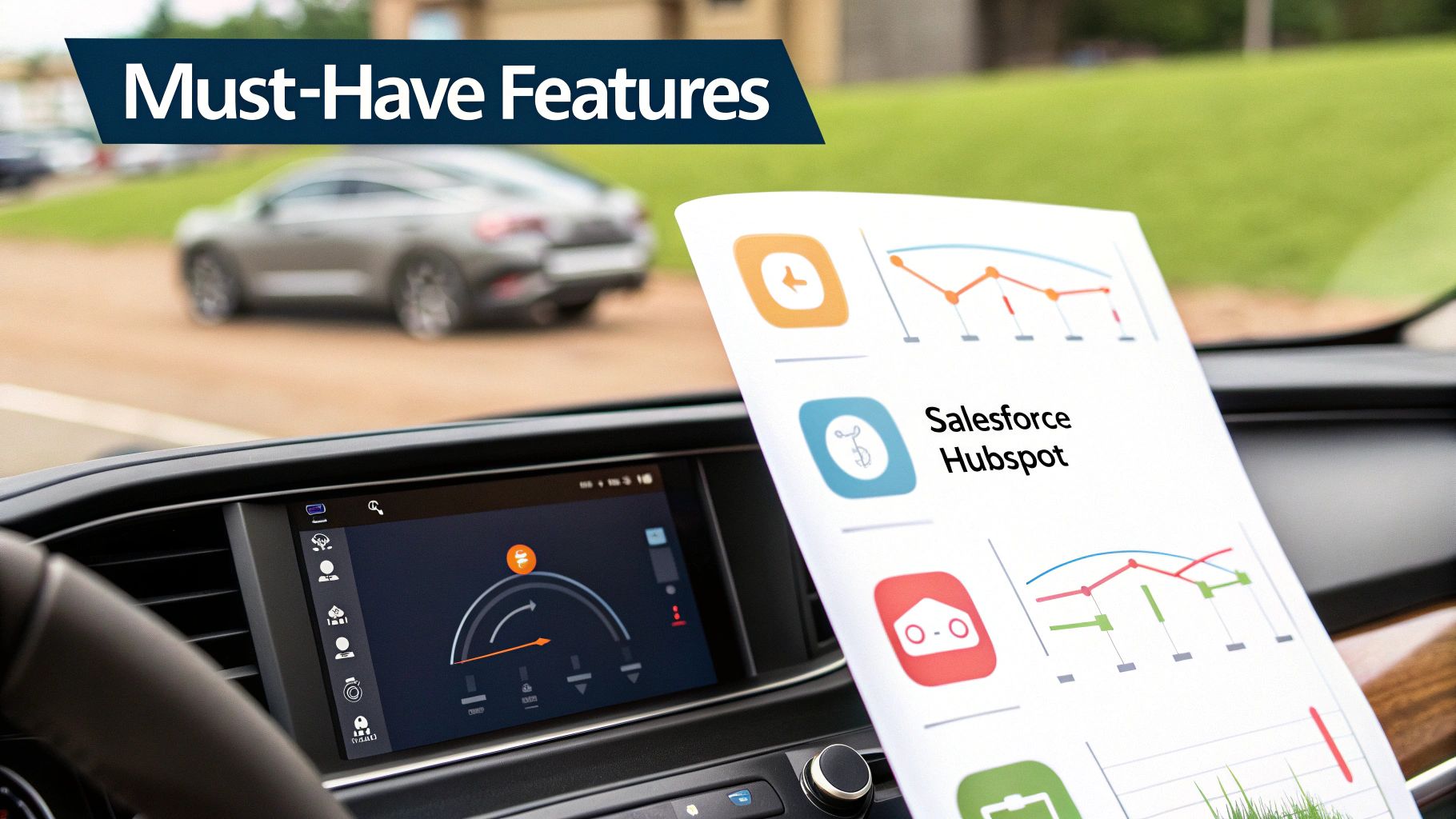A cold calling dialer is the software that takes the mind-numbing, manual work out of outbound sales. Instead of reps fumbling with phone numbers, punching in digits one by one, and then logging every single outcome, a dialer does all the heavy lifting. Think of it as the ultimate sales assistant, laser-focused on one thing: getting your reps into more conversations.
Imagine you’re a sales rep trying to hit your quota. Your day consists of hopping from one slippery stone to another to cross a massive river. Each stone is a separate, tedious task: find the number, dial it, wait for an answer, log the call, move on. It’s slow, risky, and exhausting.
Now, what if there was a solid bridge stretching across that same river? That bridge is your cold calling dialer. It gets you to the other side—to a live conversation—quickly, safely, and without all the wasted effort.
This infographic paints a perfect picture of the struggle of manual dialing versus the streamlined power a dialer brings to the table.

As you can see, it’s not just about making calls faster; it’s about completely changing the way your team approaches outreach.
It’s easy to think a dialer is just a fancy digital phone, but that’s not the whole story. A real dialer is a sophisticated software platform engineered to crush the biggest time-sinks in outbound sales.
Let’s be honest, traditional cold calling is bogged down by activities that have nothing to do with actually selling. Research shows that reps burn a huge chunk of their day on administrative tasks that generate zero revenue. A dialer tackles this problem head-on by automating that entire pre-call grind.
A cold calling dialer isn't here to replace your salespeople; it's here to empower them. It strips away all the manual busywork so they can pour 100% of their energy into the human-to-human connections that actually close deals.
To show you just how much of a difference this makes, let's compare the two approaches.
Switching from manually punching in numbers to using an automated dialer isn't a small tweak—it's a complete overhaul of your team's productivity. The table below breaks down the stark contrast in daily output.
The numbers don't lie. A dialer multiplies a rep's effectiveness, freeing them up to focus on what they were hired to do: sell.
At its core, a cold calling dialer has one primary mission: dramatically increase the number of live conversations a sales rep can have in a day. It pulls this off with a few key features that work together seamlessly:
By taking over these repetitive, low-value tasks, a dialer turns a slow, manual process into a high-velocity sales engine. For any modern sales team looking to scale up their outreach, it’s no longer a nice-to-have; it's essential.
A cold calling dialer does more than just speed up your team; it fundamentally changes their entire workflow. It’s the engine room of your outreach, taking over the slow, manual tasks that kill momentum and morale. By handling the grunt work, it frees up your reps to focus on what they do best: having high-value conversations.
Think of it like this: a sales rep without a dialer is a one-person assembly line. They have to find the parts (phone numbers), build the product (dial), and then handle quality control (logging the call). With a dialer, that entire assembly line gets automated. The rep’s only job is to step in for the final, most important stage—talking to a live prospect.
This automation directly targets agent idle time, the silent killer of sales productivity. Every second spent searching for a number, listening to endless ringing, or leaving the same voicemail over and over is a second they’re not selling. A dialer closes these gaps, creating a steady stream of live connections.

Not all dialers work the same way. The real magic happens when you pick the right dialing mode for your campaign. Each one serves a different purpose, letting you fine-tune your approach based on lead quality and how complex your sale is.
There are three main types of dialers you’ll encounter:
Choosing the right mode comes down to balancing speed with preparation. A power dialer is your rapid-fire tool for covering a ton of ground, while a preview dialer is your co-pilot, making sure you’re fully briefed for a strategic conversation.
Beyond just making calls, a cold calling dialer is packed with features that save time and boost results across the board. These tools work together to create a smooth, efficient system from beginning to end.
For example, one-click voicemail drops let a rep leave a pre-recorded, perfect message with a single click. This saves them from reciting the same script dozens of times a day. Then there’s instant call logging, which automatically syncs every call outcome, note, and recording straight to your CRM. No more manual data entry, fewer errors, and a perfectly updated system.
When every call matters, timing is everything. The average cold call lasts about 93 seconds, and analysis of over 130 million calls shows that calling between 8:00 AM and 11:00 AM can boost connection rates by 15%. A dialer helps you capitalize on these windows. Learn more about the best times for cold calling on Revenue.io.
By putting all these features together, a dialer turns a fragmented, sluggish process into a high-velocity sales machine. It transforms administrative chores into automated functions, letting your reps focus on the one thing that truly matters: building relationships and closing deals.

Alright, let's move from theory to what actually matters on the ground. We need to unpack the non-negotiable features that turn a basic dialer into a genuine sales weapon. Not all dialers are created equal, and knowing what to look for is the secret to unlocking some serious productivity gains.
Think of it like shopping for a car. Sure, any car can get you from point A to B. But the one with GPS, lane-assist, and a powerful engine makes the trip faster, safer, and a whole lot smoother. It's the exact same principle with dialers; the right features take a clunky, manual grind and transform it into a slick, automated workflow.
This is the big one. The single most critical feature of any modern dialer is its ability to plug directly into your Customer Relationship Management (CRM) platform. Without this connection, your reps are stuck doing the soul-crushing work of manual data entry—a task that's not only slow but also a magnet for errors.
A dialer with deep CRM integration becomes a natural extension of your existing system, whether you're running on Salesforce, HubSpot, or something else entirely.
This isn't just about convenience; it's the foundation of an efficient sales machine. A fully integrated system means every call, note, and outcome gets automatically logged to the right contact record. This simple function saves reps hours of mind-numbing admin work every single week.
This integration keeps your data clean and accurate, giving you a single source of truth for all your sales activities. It turns your dialer from a simple calling tool into an intelligent part of your entire sales ecosystem.
Let me ask you something: have you ever ignored a call from a random, out-of-state number? Of course you have. Your prospects do the exact same thing every single day. Local presence dialing is a game-changing feature that dramatically boosts the odds of someone actually answering your call.
It works by automatically showing a local area code on the prospect's caller ID, which makes the call feel familiar and trustworthy instead of spammy. The impact is huge; studies show that prospects are up to 400% more likely to answer a call from a local number.
This simple yet powerful feature directly translates into more live conversations for your sales team. More conversations mean more opportunities to pitch, qualify, and ultimately, close deals. It's one of the quickest ways to pump up your connection rates.
You can't improve what you don't measure. A cold calling dialer armed with call recording and analytics gives you priceless insights for coaching and fine-tuning your strategy. It lets managers listen in on real conversations, see what's working, and pinpoint exactly where reps need a bit of help.
This data-driven approach takes coaching from guesswork to a structured, repeatable process. It helps new reps get up to speed faster and gives your seasoned veterans the tools to sharpen their edge.
Of course. Here is the rewritten section, crafted to sound completely human-written and natural, following all the specified requirements.
It’s easy to think of a cold calling dialer as just a tool for saving time, but that's only scratching the surface. The real story is how it completely changes the math behind your sales efforts. A dialer isn't just an expense; it’s an investment that connects the dots between higher activity and real revenue growth.
Think about the most soul-crushing parts of a sales rep's day. A dialer automates all of that, multiplying the number of dials a rep can make. More dials naturally lead to more conversations with actual human beings.
This isn't just about moving faster; it's about building momentum. More conversations mean more swings at the bat, giving your team more chances to pitch, handle objections, and—most importantly—book meetings. That’s where the financial impact really starts to kick in.
The numbers don't lie. A rep using a dialer can easily triple their daily call output compared to dialing by hand. This isn't just a small bump; it’s a massive leap in productivity that creates a ripple effect down your entire sales funnel.
Suddenly, a rep's day shifts from being bogged down by administrative tasks to being filled with high-impact, money-making activities.
A great cold calling dialer does way more than just automate calls. It becomes your source of truth, giving you the hard data needed to build smarter, more profitable sales strategies. Managers finally get a clear view of what’s actually working and what’s not.
A dialer’s analytics dashboard is like a control panel for your sales strategy. You can finally pinpoint which scripts generate the best responses, which call times yield the highest connection rates, and which lead lists are the most fruitful.
This data-driven approach takes the guesswork out of the equation. You can double down on the tactics that are killing it and ditch the ones that are falling flat, making sure every dollar you spend is working as hard as it can.
And despite what some people might say, cold calling is far from dead in the B2B world. The data proves it: over 50% of B2B leads still come from cold calls, and a whopping 82% of buyers are open to taking a meeting that starts with one. To see just how powerful it remains, check out these insights on cold calling effectiveness.
At the end of the day, a dialer proves its worth by turning activity into analytics and analytics into actual revenue. It’s not a cost center—it's an investment that pays for itself through radical efficiency and measurable growth.
So, you're convinced a dialer is the way to go, but one look at the market and it's easy to feel lost. It's a crowded space, and picking the right cold calling dialer can feel like a huge task. The key is to have a clear process. Your goal isn't just to find a tool; it's to find the tool that fits your team's workflow like a glove. A one-size-fits-all solution often creates more headaches than it solves.
Think about it: the perfect dialer for a small B2B team chasing high-value deals will be totally different from what a massive B2C call center needs. The first step is always to look inward. Assess your team size, the length of your sales cycle, and just how complex your product or service really is.
Before you even look at a single feature, get brutally honest about your outreach goals. What are you actually trying to accomplish with these calls? A small team making a handful of strategic calls into enterprise accounts will want a preview dialer. They need time for pre-call research and a deep, seamless connection to their CRM. For them, it’s all about quality, not quantity.
On the flip side, a high-volume B2C team lives and dies by a powerful power or predictive dialer. Their entire game is built on maximizing talk time. Success is measured in hundreds of calls per day, so any feature that cuts down on agent idle time is an absolute must-have.
The right dialer speaks the language of your industry. A tool that’s a game-changer in one sector could be completely wrong for another. Understanding this from the start is how you make a smart investment.
For example, reps in e-commerce might be banging out up to 125 calls daily, while someone in tech is more likely to average around 55. Your dialer has to handle these different volumes without breaking a sweat. If you want a better feel for these benchmarks, you can find more data on daily cold call averages.
Once your strategy is locked in, you can start looking at the actual features. This is where it's easy to get sidetracked by shiny objects you'll never actually use. My advice? Make a simple checklist of your non-negotiables.
Here are the big ones to consider:
Remember, the best cold calling dialer isn't just about calling faster. It's about making your entire sales process smarter. When you take the time to match the tool to your team's real-world needs, you sidestep that common trap of buying something that's too complex or poorly integrated. That's how you find a solution that actually moves the needle.
Jumping into a new tool always comes with a few questions, and that’s a good thing. Before you commit, you want to be sure a cold calling dialer is the right move. Let's clear up some of the most common questions we hear.
This is a great question, and the answer comes down to pace and purpose.
Think of a power dialer like a dedicated assistant who tees up your next call the second you hang up the last one. It dials one number at a time, but it does it instantly, eliminating the dead space you’d normally spend manually finding and punching in the next number. This gives you a steady, controlled rhythm, which is perfect for more personalized B2B outreach where you need a moment to prep before each conversation.
A predictive dialer, on the other hand, is like having an entire team of assistants dialing for you. It uses an algorithm to call multiple numbers at once, predicting when you’ll be free and only connecting you when a real person picks up. The goal here is pure, unadulterated efficiency—to completely wipe out any downtime between live conversations. It’s a more aggressive approach, best suited for high-volume call centers running on standardized scripts.
That’s probably the biggest fear people have, and it's a totally valid one. The short answer is: not if you use a quality dialer the right way. Reputable platforms are built specifically to protect your caller ID reputation.
The old-school method of blasting hundreds of calls from a single number is a surefire way to get flagged. Modern dialers are smarter than that. They spread your calls across a pool of different numbers, which dramatically lowers the risk of carriers seeing you as spam.
On top of that, features like Local Presence Dialing help a ton. Not only does calling from a local number boost your answer rates, but it also naturally diversifies the numbers you’re calling from. The key is responsible dialing—always use clean, targeted lists and don’t just hammer the phones relentlessly.
Pricing can feel all over the map, but it almost always boils down to a per-user, per-month subscription. It's a pretty straightforward model.
For a solid system with core features like a power dialer and CRM integration, you can expect to find plans starting around $50-$75 per agent. These are great for getting started and boosting productivity right away.
If you’re looking for the whole suite—predictive dialing, deep analytics, and maybe even some AI-powered coaching—you’ll be looking at something in the $100 to $150+ per agent range. The best way to think about it isn't as a cost, but as an investment. The extra meetings booked and hours saved usually pay for the tool many times over.
Absolutely. In fact, you should consider this a deal-breaker. A cold calling dialer that doesn't talk to your CRM is only doing half its job. It just sends your reps right back to the tedious world of manual data entry, which is what you're trying to escape in the first place.
Any top-tier dialer is built to plug directly into major CRMs like Salesforce, HubSpot, Zoho, and dozens of others. This connection ensures that every call, note, disposition, and follow-up task is logged automatically and in real-time. It keeps your data pristine, saves your reps a ton of admin headaches, and makes your CRM the single source of truth it's supposed to be.
Ready to see how an AI-powered dialer can transform your outbound sales? My AI Front Desk combines a powerful AI outbound dialer with an AI receptionist to help your business convert more leads and drive more revenue.
Discover how My AI Front Desk can supercharge your sales team today!
Start your free trial for My AI Front Desk today, it takes minutes to setup!








